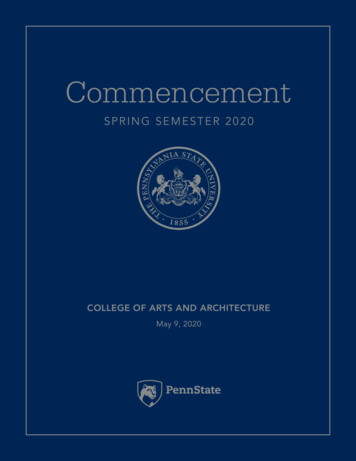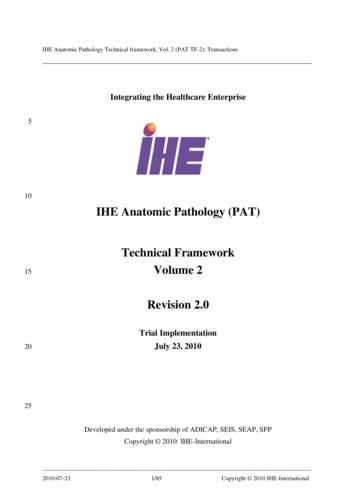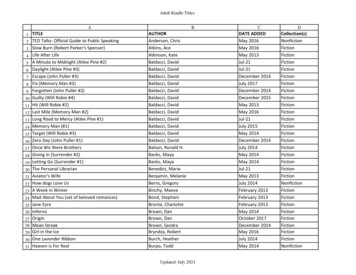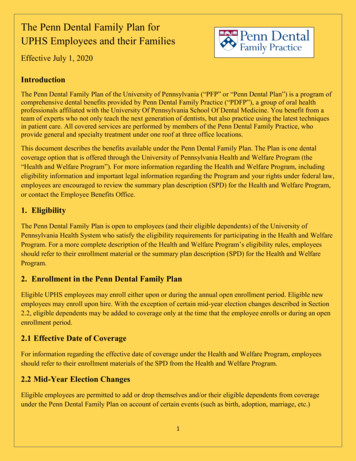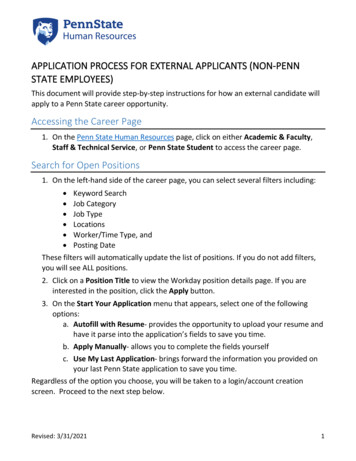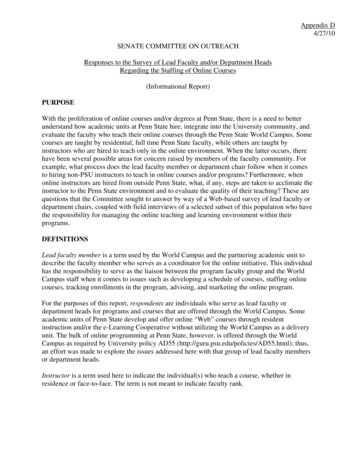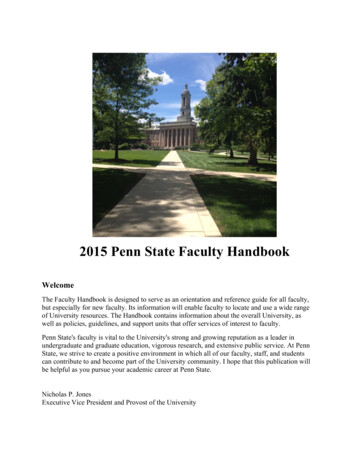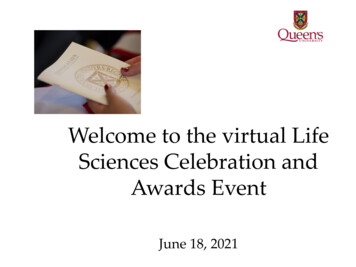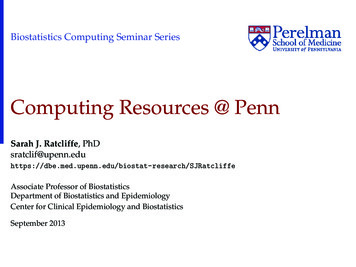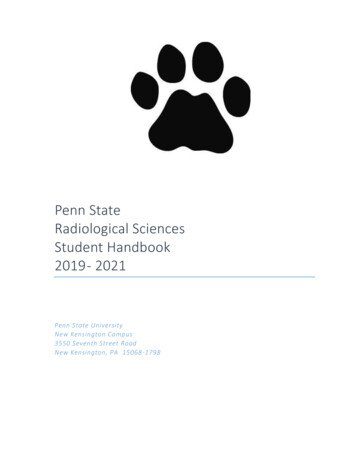
Transcription
Penn StateRadiological SciencesStudent Handbook2019 - 2021Penn State UniversityNew Kensington Campus3550 Seventh Street RoadNew Kensington, PA 15068-1798
TABLE OF CONTENTSContentsPURPOSE OF STUDENT HANDBOOK. 4Responsibility of the Student . 4Assessment Statement . .5RADIOLOGICAL SCIENCES PROGRAM OFFICIALS . 5Sponsoring Institution . 5Program Director . 5Clinical Coordinator . 5Clinical Education Sites. 5Allegheny General Hospital- a part of the Allegheny Health Network . 5Butler Memorial Hospital . 5The Western Pennsylvania Hospital- a part of the Allegheny Health Network . 6Forbes Regional Hospital – a part of Allegheny Health Network . 6UPMC St. Margaret- a part of the UPMC Health System 81 Road Freeport Pittsburgh, Pa.Program Philosophy, Mission and Goals . 7PHILOSOPHY . 7MISSION . 7GOALS & Student Learning Outcomes . 7Program Effectiveness . 8Programmatic Learning Outcomes . 8CLINICAL EDUCATION SITE REQUIREMENTS . 9PHYSICAL EXAMINATION . 9CPR (HEALTHCARE) CERTIFIED . 9HEALTH INSURANCE. 10PROFESSIONAL LIABILITY INSURANCE . 10RESPIRATOR FIT TEST . 10IDENTIFICATION BADGE . 10RADIATION MONITORING DEVICE . 10LEAD MARKERS . 11LOCKERS . 11DRESS CODE. 11UNIFORM POLICY . 11POLICY . 11PURPOSE . 11POLICY DETAIL. 12SPECIFIC DRESS CODE . 12PERSONAL HYGIENE . 12JEWELRY . 12FOOD . 13OPERATING ROOM (OR) SCRUBS . 13PENN STATE UNIVERSITY/CLINICAL EDUCATION SITE POLICIES. 13HOURS OF ATTENDANCE . 131
MAKE-UP TIME . 14SEMESTER REQUIREMENTS . 14CLINICAL ABSENTEEISM MAKE-UP TIME . 14TARDINESS – LATE ARRIVALS/LEAVING EARLY . 14TRANSFER I . 15TRANSFER II . 15STUDENTS WITH PREVIOUS RADIOLOGICAL SCIENCES . 15TRAINING / EDUCATION. 15EXTERNAL ROTATIONS . 15Wexford Health Wellness Pavilion . 17SICK TIME POLICY. 17TRANSPORTATION . 17OUTSIDE EMPLOYMENT . 18X-RAY CLUB MEETING CRITERIA . 18COMMUNICABLE DISEASE . 18CLINICAL SUPERVISION . 19Direct Supervision . 19Indirect Supervision . 19Supervision during Mobile and Surgical Radiographic procedures . 19VACATION AND SEMESTER BREAKS . 20PTO Accrual Time . 20RULES AND REGULATIONS OF THE CLINICAL SITE . 21ZERO TOLERANCE POLICY (DEMERIT SYSTEM) . 23PROGRAM POLICIES . 24HOSPITAL DRUG TESTING . 24DRUG TESTING . 25CRIMINAL HISTORY RECORD . 25MILITARY LEAVE . 25BEREAVEMENT . 26JURY DUTY. 26MEDICAL APPOINTMENTS . 26ILLNESS OR INJURY AT THE CLINICAL EDUCATION SITE . 26INTERVIEWS. 26SEMESTER REQUIREMENTS . 26LEAVE OF ABSENCE (Clinical Assignments Only) . 27A.SHORT TERM LEAVE OF ABSENCE. 27B.LONG TERM LEAVE OF ABSENCE . 27STUDENT PREGNANCY POLICY . 28STUDENT GRIEVANCE PROCEDURE/DUE PROCESS . 29HARRASSMENT POLICY . 30COUNSELING. 30INCLEMENT WEATHER POLICY . 31USE/POSSESSION OF FIREARMS . 31BEEPER/CELL (Electronic Device) PHONE POLICY . 31DEFERRED GRADE . 31RESOLUTION OF NON-COMPLIANCE . 322
mail@JRCERT.org . 32www.JRCERT.org . 32MANDATORY STOP OUT PROCEDURE . 32REQUESTED STOP OUT PROCEDURE . 32RE-ENROLLMENT POLICY . 33ACADEMICS . ng/index.html . 34CLINICAL GRADING SYSTEM . 37CLINICAL COMPETENCY EDUCATION . 37MRI SAFETY POLICY . 37TUITION . 40Because Penn State's tuition rates vary by campus, student level, program, and residency,the student tuition calculator provides specific tuition rates for individual students. . 40Tuition Penalty for Dropped Credits . 40DISIBILITY/ACCOMMODATION . 41PROFESSIONAL ORGANIZATIONS . 41UNIVERSITY STUDENT HANDBOOK . 42GLOSSARY: . 433
PURPOSE OF STUDENT HANDBOOKThe Radiological Sciences Student/Clinical/Radiation Protection & MRI SafetyHandbooks have been prepared by the Program Director, Clinical Coordinator,adjunct clinical faculty and members of the Radiological Sciences AdvisoryCommittee to acquaint the student with the policies and procedures pertinent to theRadiological Sciences Program.Because radiography is a dynamic, evolving profession, this book may be adoptingnew and updated procedures to reflect the current trends in the healthcare professionand changing mandates by accrediting agencies.Review of policy and procedures may require addendums to the handbook or mayrequire a new handbook to be issued to all current Pennsylvania State University(PSU).Responsibility of the StudentIt is the student’s responsibility to adhere to all policy and procedure of theprogram and provide updated information with regard to health insurance, liabilityinsurance, criminal history checks and drug testing, and contact informationchanges to appropriate personnel.Assessment of the ProgramThe program conducts continues continuous assessment. Part of the assessment isto identify areas in possible need for improvement. The program conducts bothgraduate and employer surveys. Please complete the survey as honestly aspossible.4
RADIOLOGICAL SCIENCES PROGRAM OFFICIALSSponsoring InstitutionPenn State UniversityNew Kensington Campus3550 Seventh Street RoadNew Kensington, PA 15068-1798Program DirectorDebra Majetic M.A.H.E., R.T.(R)Office Telephone: (724) 334-6738Fax: (724) 334-6111Email: dak@psu.eduClinical CoordinatorMarcia Curler B.S.R.T. (R)(CT)Office Telephone: (724) 334-6722Fax: (724) 334-6111Email: mac51@psu.eduClinical Education SitesAllegheny General Hospital- a part of the Allegheny Health Network3210 East North AvenuePittsburgh, PA 15212Clinical Instructor: Morgan HendersonOffice Telephone: (412) 359-6992Work Cell: (412) 522-6885Department Telephone: (412) 359-4874Email: morgan.henderson@ahn.orgButler Memorial HospitalOne Hospital WayButler, PA 16001Clinical Instructor: Amanda Maley B.S. R.T.(R)Department Telephone: (724) 284-4568Voicemail: (724) 284-4576Fax: (724) 284-7477Email: Amanda.maley@butlerhealthsystem.org5
The Western Pennsylvania Hospital- a part of the Allegheny Health Network4800 Friendship AvenuePittsburgh PA 15224Clinical Instructor: Dave Flatt A.S.R.T.(R)Clinical Instructor: Carl Tutak A.S. R.T. (R)Office Telephone: (412) 578-1590Department Telephone (412) 578-1578 or (412) 578-1598Fax: (412) 578-1693Email: David.Flatt@ahn.orgCarl.tutak@ahn.orgForbes Regional Hospital – a part of Allegheny Health Network2570 Haymaker RoadMonroeville, PA 15146Clinical Instructor: Julie Skultety R.T.(R)Voicemail: (412) 367-0496Department Telephone: (412) 858-2416 option #1Fax: (412) 858-2124Email: JulieSkultety@ahn.orgUPMC St. Margaret- a part of the UPMC Health System81 Road FreeportPittsburgh, Pa. 15215Clinical Instructor: Sue KostewiczClinical Instructor: Erin StivensonVoicemail: 412-784-7858Department Telephone: 412-784-4273Email: kostsx2@upmc.edustivea@upmc.eduWexford Health Wellness Pavilion12311 Perry HighwayWexford, PA 15090Clinical Instructor: Jacquelyn MorrisonDepartment Telephone: (878) 332-4280Email: Jacki.Morrison@ahn.org6
Program Philosophy, Mission and GoalsPHILOSOPHYRadiological sciences is an art and science program based upon principles and techniques whichare utilized by members of the profession in meeting the needs of the patients while carrying outspecific responsibilities within the multicultural medical environment.Learning is a continuous process of assimilation of knowledge and progressive development ofthe student toward pre-established goals. Learning is dependent upon the readiness, motivationand active participation of the student, the student's self - determined goals, and progress towardthose goals.The Penn State New Kensington Radiological Sciences program comprises three distinct but interrelated components. First, a general education background is necessary for professionals tocommunicate effectively and intelligently. Second, Radiological Sciences is focused course workthat develops technical knowledge and critical thinking skills and promotes professional ethics.Third, a clinical component prepares the student through supervised competency basedexperiences to function as a skilled radiographer.MISSIONOur mission is to develop competent professional radiographers whose expertise will meet theneeds of the community they serve by providing high quality healthcare in a professional,compassionate and responsible manner.GOALS & Student Learning OutcomesThe goals of Penn State New Kensington Radiologic Sciences Program are to:Goal: Practice as entry level technologists.Student Learning Outcomes:The student will provide proper radiation protection.The student will demonstrate proper positioning skills.The student will evaluate diagnostic images.Goal: Effectively communicate in the healthcare environment.Student Learning Outcomes:The student will demonstrate effective written communication skills.The student will provide effective oral communication skills.The student will treat all patients with compassion.7
Goal: Think critically and apply problem solving skills in the healthcare environment.Student Learning Outcomes:The student will manipulate technical factors to produce diagnostic images.The student will modify procedures to meet patient needs.Goal: Understand and promote the importance of professional growth and development.Student Learning Outcomes:The student will demonstrate professional behavior and participate in professionalorganizations.The student will develop a career portfolio and plan for compliance within the profession.Program EffectivenessThe program will consistently monitor the following.1. Students will pass the ARRT national certification on the 1st attempt within 6 months ofgraduation.2. Students will complete all requirements of program in established time frame. (6semesters).3. Of those pursuing employment, students will be gainfully employed within one year postgraduation.4. Students will be satisfied with their education.5. Employers will be satisfied with the graduate’s performance.Programmatic Learning OutcomesUpon completion of the program, the student will:1. Apply knowledge of anatomy, physiology, position and radiographic technique toaccurately demonstrate anatomical structures on radiographs or other image receptors.2. Determine exposure factors to achieve optimum radiographic quality with minimumradiation exposure to the patient.3. Evaluate radiographic images for appropriate positioning and image quality.4. Apply principles of radiation protection to the patient, self and others.5. Provide care, comfort and attend to the needs of the patient.8
6. Recognize emergency patient conditions and initiate life-saving first aid and basic lifesupport procedures.7. Detect equipment malfunctions, report to proper authority and know the safe limits ofequipment operation.8. Participate in radiologic quality assurance programs.9. Communicate effectively in the medical environment and function as a team member in aradiology department.10. Participate in professional activities and continuing education, demonstrate anunderstanding of advanced imaging modalities and utilize insights gained inliberalarts and science courses to promote continued professional and personal growth.CLINICAL EDUCATION SITE REQUIREMENTSAll students will complete a physical examination, background checks, drug testing, purchaseliability insurance, CPR for Healthcare Providers, HIPAA compliance and purchase lead markers.All students will submit required information to Castlebranch (a student record managementsystem) by established deadlines. It is the Clinical Instructors or designated appointee of eachclinical affiliate responsibility to review the student records. All Clinical Instructors have attendedwebinars with Castlebranch with a question and answer session to follow. In the event an issueoccurs with any student record the Clinical Instructor of the clinical affiliate will follow establishedpolicy and procedure of the clinical affiliate. (Please see program website FAQ sheet for a list ofrequirements of the clinical affiliates for students to complete clinical rotations.) The abovementioned is NOT a requirement of PSU but a requirement of the clinical affiliates of the program.PHYSICAL EXAMINATIONEach student must undergo a physical examination prior to his/her assignment of clinical educationbefore the student begins the program. The physical must be completed within one year prior tostart of clinical assignments. Proof of such examination must be submitted as well as copy ofcurrent immunizations and two step PPD. The physical examination is a requirement of the clinicalaffiliates and NOT of PSU. All information must be submitted to Castlebranch and/or designatedpersonnel for review.CPR (HEALTHCARE) CERTIFIEDAll students must remain current with CPR certification throughout the entire program. Allstudents must provide proof of CPR certification for Healthcare Providers to designated personneland Castlebranch. Any lapse in certification will result in immediate suspension of the program.All missed clinical rotations will made up according to the Make-up Policy.9
HEALTH INSURANCEEach student must provide proof of health insurance at his/her own expense. Health insuranceinformation through PSU can be found at lthinsurance .It is the student’s responsibility to submit such evidence of insurance to the programfaculty and Castlebranch prior to the start of clinical assignments. The student must maintaincurrent and effective health insurance throughout the program. Any lapse in health insurance willresult in immediate suspension of the program.PROFESSIONAL LIABILITY INSURANCEAll students must obtain professional/general liability insurance with minimum limits of 1,000,000.00 per claim and 3,000,000.00 in the aggregate, which covers activities whilecompleting clinical rotations in the Radiology Department of PSU clinical sites. This policymust be renewed annually and upon receipt of such policy by the student, it is his/herresponsibility to submit to Castlebranch. Students are not permitted to complete clinicalrotations without a current liability insurance policy and associated fees in effect. Lapse ofliability insurance will result in immediate suspension from the program. Students will beresponsible for any/all expenses in the event liability insurance LAPSES and a liability situationoccurs during a clinical rotation.RESPIRATOR FIT TESTClinical site policy will be followed for the respirator fit testing. If tested, the student must submitdocumentation to Castlebranch annually. All facial hair must be removed by the student duringthe initial or re-fit before the test can be performed.IDENTIFICATION BADGEAn identification badge must be worn all times while at the clinical site (either Clinical site issuedor PSU ID badge). Any student NOT wearing the ID badge will be sent home and the time willbe made up at the end of the semester. The Zero Tolerance Policy (see Zero Tolerance Policy) ofthe program will be followed. A replacement cost will be charged by the clinical site if it is lostor misplaced. Upon termination of the student’s clinical education, the ID badge must be returnedto the Clinical Instructor of the clinical site. A hold will be placed on the student’s account if thebadge is not returned upon termination.RADIATION MONITORING DEVICEThe Radiation Physics Department will furnish a Radiation Monitoring Device to the student.Dosimetry reports will be reviewed at each clinical site. The badge is to be left at the clinical site(exception – external rotation) in designated areas. It is the student’s responsibility to followclinical site policy for review of dosimetry report. Any student NOT wearing the radiationmonitoring device will be sent home and the time will be made up at the end of the semester. TheZero Tolerance Policy will be followed. Upon termination of the student’s clinical education, theradiation monitoring device must be returned to the Clinical Instructor of the clinical site. A holdwill be placed on the student’s account if the badge is not returned upon termination.10
LEAD MARKERSEach student must purchase 2 sets of lead positional markers for proper image identification. Nostudent will be permitted to attend clinical rotations without lead markers. It is the student’sresponsibility to replace lost or stolen lead markers. Each marker must have 3 initials. The letter‘x’ will be used if student does not have a middle initial. Students will be given websiteinformation to purchase lead markers during RADSC new student orientation. Students mustpurchase red markers for the right and blue markers for the left hen purchasing markers.LOCKERSEach student will be issued a locker or space for personal belongings at the clinical site. Thestudent is responsible for securing any valuables. Locker space is provided free of charge,however, the student must purchase either a combination or key lock at his/her expense. Contactthe business office on campus for arrangements for lockers on campus. A fee is charged for thelockers on campus. Upon voluntary/involuntary termination from the program, the student willhave one week to remove belongings at the clinical site. Any lock/belongings left by any studentafter one week after termination, hospital security will be notified to remove lock and contents willbe discarded.DRESS CODEAll radiography students will abide by the dress code established by the program faculty. It is thestudent’s responsibility to purchase uniforms and lab coats at his/her own expense through PennState New Kensington bookstore.UNIFORM POLICYPOLICYAll students are to maintain a professional appearance in keeping with their respective types ofwork and activity. In addition, all students must wear identification and radiation monitoringdevice as part of the departmental dress code. Lead markers are also part of the uniform. Allstudents must be in uniform at all times while at the clinical site.PURPOSEA. To provide a quality appearance for the patient, general public, fellow students andemployees of the department and hospital.B. To provide a means of identification of radiology students and assure patients that studentsperforming a particular service have the authority to do so by using a standard dress andcolor.11
C. To avoid arousing emotional reactions in patients by unconventional dress and symbolicaccessories.POLICY DETAILIt is the responsibility of each individual to appear neat and well groomed. Uniforms must bestandardized and purchased from the Penn State New Kensington bookstore, neat, clean andpressed.SPECIFIC DRESS CODE1. Black clinical shoes/black athletic shoes (clogs, crocs, and sandals are not acceptable).2. Shoes and laces are to be clean and in good condition.3. Black hose, black knee hi’s or plain black socks must be worn at all times. Socks mustcover the ankle.4. Uniform top – navy blue PSU regulation.5. Uniform slacks – navy blue PSU regulation.6. Lab coat – white PSU regulation. Must be worn at all times during operating room rotationsif in designated operating room uniforms.7. Undergarments must be conservative and should not be visible.8. A plain white undershirt, long sleeved shirt or turtleneck sweater is permitted under theuniform. No clothing bearing commercial logos or printing of any kind, or “thumb hole”shirts are permitted.9. All male students must wear plain white undershirt to eliminate visible chest hair.10. Identification badge and radiation monitoring device must be worn at all times. Radiationmonitoring device must be left in designated areas at the end of each clinical rotation withthe exception of external rotations. Student must also have designated lead markers forproper image identification.PERSONAL HYGIENE1. Moderate makeup/body fragrances.2. Fingernails should be clean and length should not exceed the fingertip. The length mustnot interfere with clinical functions not to exceed ¼ inch in length beyond fingertip.Extreme shades of fingernail polish are to be avoided – only light or neutral colors. Noacrylic nails or fake nails of any kind or gel nail polish.3. Hair must be neat and clean in appearance. Length of hair that exceeds shoulder level mustbe pulled back in a bun, braid or ponytail. No unnatural hair colors or styles (ex.- purplehair, mohawk, etc.)4. Visible body art work (tattoos) must be kept covered at all times.5. Facial hair- neatly groomed and close to face (Must be removed for respirator fit testing)JEWELRY1. Jewelry shall be limited to items of modest value, such as one watch (colored watches maybe white or blue the watch cannot be a smart watch or fitbit), one ring per hand and post12
earrings only. No other visible body piercing is permitted including clear spacers. Onepost-type earring stud per ear lobe ONLY is permitted. No ornamental chains on neck,wrists, or anklets. Necklaces, bracelets, or anklets of any kind regardless if under clothingare NOT permitted.2. Rings should not be the protruding types set up on prongs as they are likely to cut the skin.
Allegheny General Hospital- a part of the Allegheny Health Network 3210 East North Avenue Pittsburgh, PA 15212 Clinical Instructor: Morgan Henderson Office Telephone: (412) 359-6992 Work Cell: (412) 522-6885 Department Telephone: (412) 359-4874 Email: morgan.henderson@ahn.org Butler Memorial Hospital One Hospital Way Butler, PA 16001

